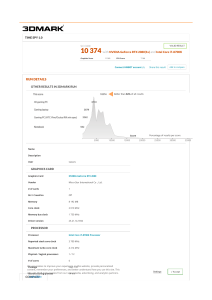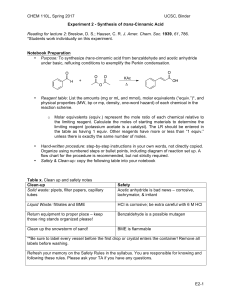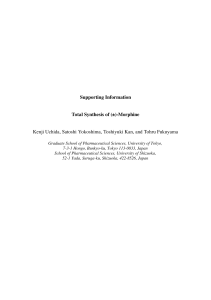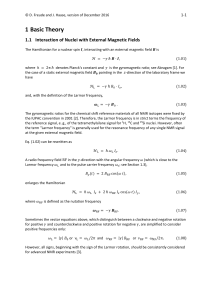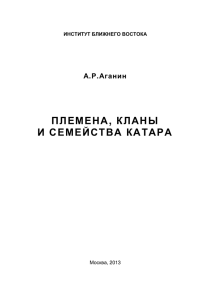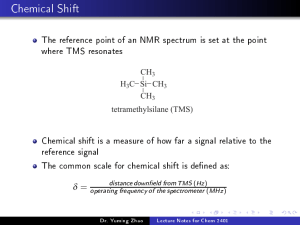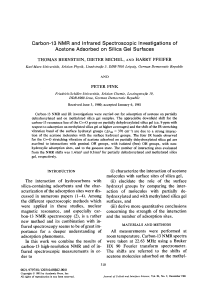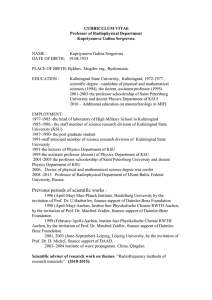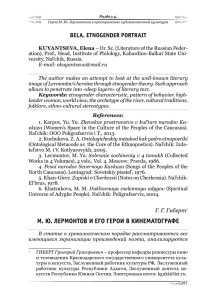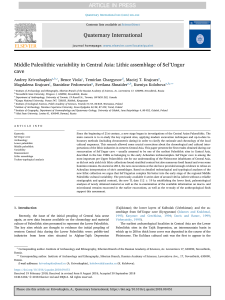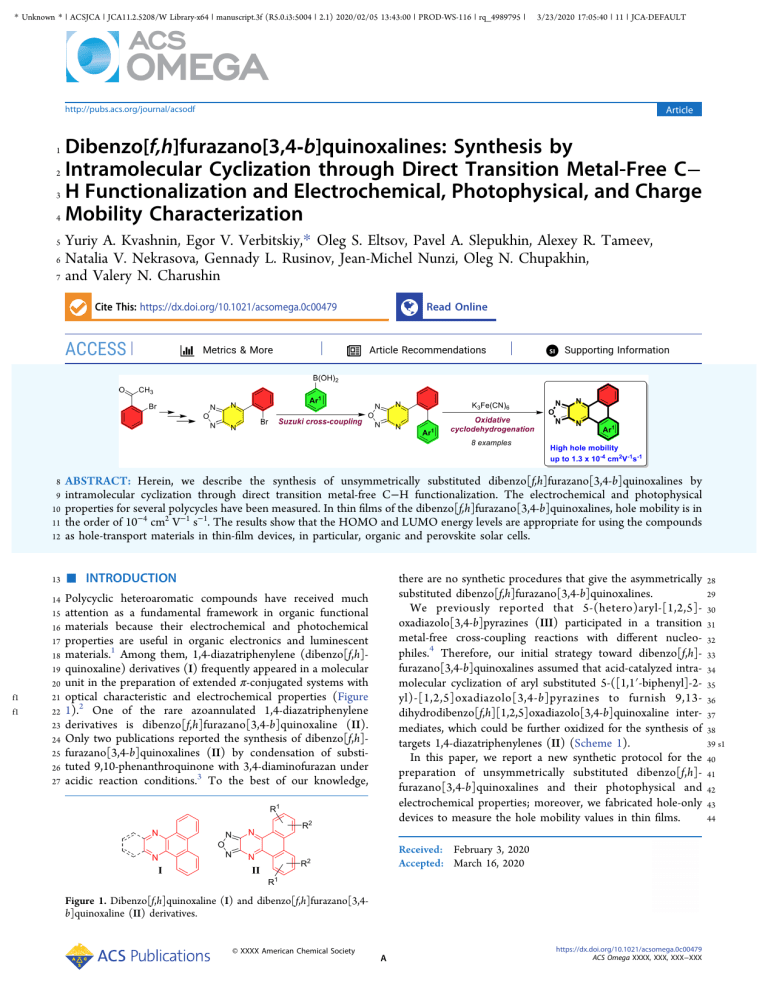
* Unknown * | ACSJCA | JCA11.2.5208/W Library-x64 | manuscript.3f (R5.0.i3:5004 | 2.1) 2020/02/05 13:43:00 | PROD-WS-116 | rq_4989795 |
3/23/2020 17:05:40 | 11 | JCA-DEFAULT
http://pubs.acs.org/journal/acsodf
Article
Dibenzo[f,h]furazano[3,4‑b]quinoxalines: Synthesis by
2 Intramolecular Cyclization through Direct Transition Metal-Free C−
3 H Functionalization and Electrochemical, Photophysical, and Charge
4 Mobility Characterization
1
Yuriy A. Kvashnin, Egor V. Verbitskiy,* Oleg S. Eltsov, Pavel A. Slepukhin, Alexey R. Tameev,
Natalia V. Nekrasova, Gennady L. Rusinov, Jean-Michel Nunzi, Oleg N. Chupakhin,
7 and Valery N. Charushin
5
6
Cite This: https://dx.doi.org/10.1021/acsomega.0c00479
ACCESS
8
9
10
11
12
13
14
15
16
17
18
19
20
f1
21
f1
22
23
24
25
26
27
Metrics & More
Read Online
Article Recommendations
sı Supporting Information
*
ABSTRACT: Herein, we describe the synthesis of unsymmetrically substituted dibenzo[f,h]furazano[3,4-b]quinoxalines by
intramolecular cyclization through direct transition metal-free C−H functionalization. The electrochemical and photophysical
properties for several polycycles have been measured. In thin films of the dibenzo[f,h]furazano[3,4-b]quinoxalines, hole mobility is in
the order of 10−4 cm2 V−1 s−1. The results show that the HOMO and LUMO energy levels are appropriate for using the compounds
as hole-transport materials in thin-film devices, in particular, organic and perovskite solar cells.
■
INTRODUCTION
Polycyclic heteroaromatic compounds have received much
attention as a fundamental framework in organic functional
materials because their electrochemical and photochemical
properties are useful in organic electronics and luminescent
materials.1 Among them, 1,4-diazatriphenylene (dibenzo[f,h]quinoxaline) derivatives (I) frequently appeared in a molecular
unit in the preparation of extended π-conjugated systems with
optical characteristic and electrochemical properties (Figure
1).2 One of the rare azoannulated 1,4-diazatriphenylene
derivatives is dibenzo[f,h]furazano[3,4-b]quinoxaline (II).
Only two publications reported the synthesis of dibenzo[f,h]furazano[3,4-b]quinoxalines (II) by condensation of substituted 9,10-phenanthroquinone with 3,4-diaminofurazan under
acidic reaction conditions.3 To the best of our knowledge,
there are no synthetic procedures that give the asymmetrically
substituted dibenzo[f,h]furazano[3,4-b]quinoxalines.
We previously reported that 5-(hetero)aryl-[1,2,5]oxadiazolo[3,4-b]pyrazines (III) participated in a transition
metal-free cross-coupling reactions with different nucleophiles.4 Therefore, our initial strategy toward dibenzo[f,h]furazano[3,4-b]quinoxalines assumed that acid-catalyzed intramolecular cyclization of aryl substituted 5-([1,1′-biphenyl]-2yl)-[1,2,5]oxadiazolo[3,4-b]pyrazines to furnish 9,13dihydrodibenzo[f,h][1,2,5]oxadiazolo[3,4-b]quinoxaline intermediates, which could be further oxidized for the synthesis of
targets 1,4-diazatriphenylenes (II) (Scheme 1).
In this paper, we report a new synthetic protocol for the
preparation of unsymmetrically substituted dibenzo[f,h]furazano[3,4-b]quinoxalines and their photophysical and
electrochemical properties; moreover, we fabricated hole-only
devices to measure the hole mobility values in thin films.
Received: February 3, 2020
Accepted: March 16, 2020
Figure 1. Dibenzo[f,h]quinoxaline (I) and dibenzo[f,h]furazano[3,4b]quinoxaline (II) derivatives.
© XXXX American Chemical Society
A
https://dx.doi.org/10.1021/acsomega.0c00479
ACS Omega XXXX, XXX, XXX−XXX
28
29
30
31
32
33
34
35
36
37
38
39 s1
40
41
42
43
44
ACS Omega
http://pubs.acs.org/journal/acsodf
Article
Scheme 1. Interaction of 5-(Hetero)aryl-[1,2,5]oxadiazolo[3,4-b]pyrazines with Different Nucleophiles through a Transition
Metal-Free Cross-Coupling Reactions
Scheme 2. Synthesis of 5-(2-Bromophenyl)-[1,2,5]oxadiazolo[3,4-b]pyrazine (3)
Table 1. Optimization of the Suzuki Cross-Coupling Reaction Conditions
45
46
47
48
s2
49
50
51
52
53
54
55
56
t1
57
58
s3
s3
59
60
61
62
63
64
65
66
67
68
69
70
entry
Pd catalyst/ligand (equiv)
base (2.5 equiv)
PhB(OH)2 content (equiv)
solvent
yield (%)
1
2
3
4
Pd(PPh3)4 (5 mol %)
Pd(PPh3)4 (10 mol %)
Pd(OAc)2 (5 mol %)/PPh3 (10 mol %)
Pd(PPh3)4 (5 mol %)
K2CO3
K2CO3
K3PO4
K3PO4
2.0
2.0
2.0
1.2
1,4-dioxane/H2O (5:1)
1,4-dioxane/H2O (5:1)
1,4-dioxane
1,4-dioxane
16
45
17
66
■
RESULTS AND DISCUSSION
Synthesis. At the first stage, the parent 5-(2-bromophenyl)-[1,2,5]oxadiazolo[3,4-b]pyrazine (3) was obtained via the
two-step procedure from readily available 2′-bromoacetophenone (1) in 79% overall yield (Scheme 2).
Further, it was necessary to synthesize the series of 5-([1,1′biphenyl]-2-yl)-[1,2,5]oxadiazolo[3,4-b]pyrazine derivatives.
5-(2-Bromophenyl)-[1,2,5]oxadiazolo[3,4-b]pyrazine (3) reacted with phenylboronic acid (4a) to give 5-([1,1′biphenyl]-2-yl)-[1,2,5]oxadiazolo[3,4-b]pyrazine (5a) under
the Suzuki cross-coupling condition. Examination of the
palladium catalysts showed that Pd(PPh3)4 in dry 1,4-dioxane
gave the desired product 5a in the best yield (Table 1, entry 4).
Based on the above results, the structural diversity of various
arylboronic acids (4a−4h) was examined. As shown in Scheme
3, a wide range of mono-, di-, and trisubstituted phenylboronic
acids, bearing both electron-donating and electron-withdrawing substituent groups, could react with 3 for the synthesis of
the corresponding 5-bis(aryl)-substituted [1,2,5]oxadiazolo[3,4-b]pyrazines (5a−5h). As can be seen, the electronic
character of the substituents of phenylboronic acids does not
have an influence on their reaction activity. In all cases, the
Suzuki cross-coupling occurred smoothly to give the desired
products 5a−5h in good yields of 51−82% (Scheme 3).
Next, we tried to intramolecular cyclize bis(aryl)-substituted
[1,2,5]oxadiazolo[3,4-b]pyrazines (5a−5h) into corresponding
Scheme 3. Synthesis of 5-([1,1′-Biphenyl]-2-yl)[1,2,5]oxadiazolo[3,4-b]pyrazine Derivatives (5a−5h)
9,13-dihydrodibenzo[f,h][1,2,5]oxadiazolo[3,4-b]quinoxaline
by action of CF3COOH as the best solvent, as shown earlier.4
The intermediate products 6 were precipitated as white
powders in good yields of 56−95%. Notably, compounds 6b
and 6d were not isolated in their pure forms due to high
solubility in CF3COOH. In these cases, the solvent was
removed, and the resulting semisolid residue was oxidized to
desired 1,4-diazatriphenylenes 7b and 7d without additional
purification. Of note, it was found that 2,4-difluoro-9,13B
https://dx.doi.org/10.1021/acsomega.0c00479
ACS Omega XXXX, XXX, XXX−XXX
71
72
73
74
75
76
77
78
79
ACS Omega
http://pubs.acs.org/journal/acsodf
Article
Scheme 4. Synthesis Dibenzo[f,h]furazano[3,4-b]quinoxaline (DBFQ) Derivatives (7a−7h)
Scheme 5. Structure of Two Possible Regioisomers: 3-Fluorodibenzo[f,h][1,2,5]oxadiazolo[3,4-b]quinoxaline (7e) or 1Fluorodibenzo[f,h][1,2,5]oxadiazolo[3,4-b]quinoxaline (7e′)
Figure 2. 2D NMR NOESY (400 MHz, CDCl3) spectrum of 7e at 313 K.
80
81
82
inductive effect of two fluorine atoms, which complicate the
intramolecular electrophilic attack on the 1,1′-biphenyl
substituents. The obtained 9,13-dihydrodibenzo[f,h][1,2,5]-
dihydrodibenzo[f,h][1,2,5]oxadiazolo[3,4-b]quinoxaline (6g)
is not formed under the given reaction conditions. We suggest
that it is due to the uncoordinated electron-withdrawing
C
https://dx.doi.org/10.1021/acsomega.0c00479
ACS Omega XXXX, XXX, XXX−XXX
83
84
85
ACS Omega
86
87
88
s4
89
90
91
s5
92
93
94
f2
95
96
97
98
99
100
101
102
103
104
105
106
f3
107
http://pubs.acs.org/journal/acsodf
oxadiazolo[3,4-b]quinoxalines (6a−6f and 6h) were oxidized
with K3Fe(CN)6 in an alcohol solution (NaOH) for 24 h to
afford target dibenzo[f,h]furazano[3,4-b]quinoxalines (7a−7f
and 7h) in high yields of 69−96% (Scheme 4).
At the cyclization of the compound 5e, the formation of two
regioisomeric products, which differ at the C(1) or C(3)
position of the fluorine atom, is possible (Scheme 5). To
unambiguously confirm the structure of the polycyclic
compound 7e or 7e′, two-dimensional NOESY spectrum was
recorded for this compound (Figure 2). Particularly, for the
proposed structure of 7e′ in the NOESY spectrum, cross-peaks
due to spatial interactions of the protons H(2), H(3), and
H(4) forming the common system should be expected.
Besides, the interactions with neighboring protons H(2) and
H(4) should be observed for proton H(3). However, no crosspeaks with any of the neighboring protons were detected for
proton H(4) in the NOESY experiment. Furthermore, for the
other protons of the aromatic system H(1) and H(2), the
interactions only with each other have been observed. This
evidence unambiguously supports the structure of 7e.
Notably, the structure of 7h was established by X-ray
diffraction analysis (Figure 3). According to the XRD data,
(corresponding to the HOMO energy levels) were calculated
by subtracting the optical energy gap Egopt (estimated from the
long-wavelength absorption edge of the absorption spectra8
recorded in CH2Cl2 solution shown in Figures S8−S14) from
the LUMO energy values (Table 2). The compounds under
study are considered to be used in the solid state, so the similar
optical and electrochemical parameters, as well as hole mobility
(Table 2), were measured in their thin solid films (see
Experimental Section). Both HOMO and LUMO energy levels
of the compounds in solution are downshifted compared with
those in solid films because of the influence of the
reorganization energy of the electrolyte on the dispersion of
the energy level of the substance in solution.
Computational Data. The DFT calculations of the
HOMO levels and the energy gap, as well as the dipole
moment of molecules in the neutral state, were done at the
B3LYP/6-31G* level of theory in vacuum.9 The computational
data are shown in Table 2. The results show that the HOMO
and LUMO levels were uniformly overestimated in the DFT
calculations, presumably because the calculations were
performed in a vacuum. The calculated band gap energies
Egcalc are systematically higher than the experimental Egopt
values.
Hole Mobility. Organic semiconductors that can potentially be used as a charge-transporting material must possess
reasonable charge carrier mobility values. Thus, we prepared
specimens of a diode structure ITO/SiO2/ DBFQ/Au where
the SiO2 insulator layer blocked injection of charge carriers
from the ITO electrode in CELIV measurements (see
Experimental Section). The data on hole mobility in the
solid films of dibenzo[f,h]furazano[3,4-b]quinoxalines are also
summarized in Table 2. The hole mobility in the 7a, 7d, and
7e films is 2.5−6 times larger than that in the 7b, 7c, 7f, and 7h
films.
The charge carrier transport in organic and polymer solids
can be represented in terms of the redox process.10−13 The
hole transport is considered as a chain of redox reactions,
consisting of one electron transfer from the HOMO of the
neutral molecules to the single occupied molecular orbital
(SOMO) of the neighbor radical cations. When the neutral
molecule is charged positively, its conformation is transformed
to accommodate the minimum energy state of the radical
cation. In turn, when the SOMO of the radical cation accepts
the second electron, its conformation is also transformed.
Evidently, such molecule reorganization influences the
probability of the intermolecular electron transfer and, as a
consequence, the mobility of charge carriers. Indeed, molecule
7a consists of a solid core backbone, whereas other molecules
have substituents, which can cause molecule conformation
transformations during charge transfer. The fluorine substituent in the 7d and 7e molecules seems to initiate negligible
transformations between the charged and neutral states of the
molecules, so the high hole mobility for their films obeys the
suggested approach as well.
It is understood that the packing of the molecules in solid
films influences the charge carrier transport. As was discussed
above, 7a and 7c−7h molecules tend to form strong
intermolecular π−π stacking interactions. In consequence, we
can expect relatively high charge mobility in their films in
accordance with the fact that charge transport along the axis of
such stack is faster than in any other direction.13 Nevertheless,
the hole mobility in the 7c, 7f, and 7h films is lower than that
Figure 3. ORTEP of 7h with thermal ellipsoids at the 50% probability
level.
108
109
110
111
112
f4
113
114
115
116
117
118
119
120
121
122
123
124
125
126
127
128
129
130
131
Article
compound 7h crystallized in the noncentrosymmetric space
group. The polycyclic system is planar (Figure 3). The
fluoroaryl fragment is disordered in the plane with an
occupancy coefficient of 0.85/0.15. The mean bond distances
and angles of the molecules are near to standard. In the crystal,
the molecules form the twisted slanting stacks (Figure 4a−c),
with interfacial distances of adjacent molecules being
approximately 3.3 Å (Figure 4d), which is near the layer
distance in graphite (3.35 Å).5 This is a characteristic for a
pronounced π−π interaction between two aromatic cores.
These results suggest that the other analogue polycycles 7a and
7c−7f without the bulky propping tert-butyl group also may
hold strong intermolecular π−π stacking interactions. In fact,
relatively poor solubility was observed for 7d, 7e, and 7h,
which reflects the strong π−π interactions.6
Optical and Photophysical Properties. The electrochemical properties of dibenzo[f,h]furazano[3,4-b]quinoxalines (7a−7f and 7h) were studied using cyclic
voltammetry under conditions previously described for similar
heteroacene systems.7 The cyclic voltammograms shown in
Figures S1−S7 demonstrate the irreversible character of the
reduction of compounds 7a−7f and 7h. Given that no anodic
behavior of 1,4-diazatriphenylenes (7a−f and h) could be
recorded by CV, their excited state oxidation potentials
D
https://dx.doi.org/10.1021/acsomega.0c00479
ACS Omega XXXX, XXX, XXX−XXX
132
133
134
135
136 t2
137
138
139
140
141
142
143
144
145
146
147
148
149
150
151
152
153
154
155
156
157
158
159
160
161
162
163
164
165
166
167
168
169
170
171
172
173
174
175
176
177
178
179
180
181
182
183
184
185
186
187
188
189
190
191
192
193
ACS Omega
http://pubs.acs.org/journal/acsodf
Article
Figure 4. Molecular packing for 7h (a) in the plane [100], (b) along the plane [8 24 0], and (c) in the plane [001]. (d) Fragment of stack with
interfacial distances in Å.
194
195
196
197
198
199
200
201
202
203
204
205
206
207
208
209
210
211
212
213
214
215
216
217
218
219
220
in the 7a, 7d, and 7e films. In this regard, the dipole nature of
the bulk of the films may be taken into account as well.14,15
In accordance with the well-developed correlated disorder
model (CDM),15 considering the Gaussian distribution of
density of states, the following relationship describes charge
mobility (see eq 1)
ÄÅ
É
ÅÅi 3σ y2
iji σ y3/2
yz i eRF y1/2 ÑÑÑÑ
ÅÅj
j
z
z
z ÑÑ
z + C0jjjjj zzz − Γzz jjj
μ = μ0 expÅÅjj
jk kT {
z k σ zz{ ÑÑÑ
ÅÅk 5kT z{
(1)
k
{
ÅÅÇ
ÑÑÖ
similar dipole moment. It means that the CDM does not apply
to the 7a films. We may suppose that the degree of ordering
(stacking) of the 7a molecules in the film formed on a glass/
ITO/SiO2 substrate is higher than that of the 7b, 7f, and 7h
molecules.
221
CONCLUSIONS
In summary, we have developed a new approach for the
synthesis of unsymmetrical dibenzo[f,h]furazano[3,4-b]quinoxalines via intramolecular oxidative cyclodehydrogenation of the corresponding 5-phenylaryl(hetaryl)-substituted
[1,2,5]oxadiazolo[3,4-b]pyrazines. The present synthetic procedure provides a facile way to the family of nitrogencontaining polycyclic heteroaromatic compounds that can
potentially be used in organic electronics and luminescent
materials.
Namely, we observed that a compromise between molecule
stiffness, molecule dipole moment, and intermolecular packaging defines the mobility of holes in the solid films of the
dibenzo[f,h]furazano[3,4-b]quinoxalines. In the films, hole
mobility in the order of 10−4 cm2 V−1 s−1 was experimentally
measured, which makes the compounds promising holetransporting materials for organic electronics. In particular,
7b−7h compounds are promising candidates for the holetransport layer in perovskite solar cells. Under similar
conditions, the CELIV mobility of the pristine staplecompound Spiro-MeOTAD,16 which is commonly used as
the hole-transport layer, was 8.5 × 10−7 cm−2 V−1 s−1 (for
comparison, the hole mobility obtained from space charge
limited current and time-of-flight measurements reached 2 ×
226
■
where C0 = 0.78, Γ = 2, μ0 is the pre-exponential factor, R is
the distance between charge transport sites, F is the applied
electric field, e is the electron charge, k is the Boltzmann
constant, T is the temperature, and σ is the root mean square
width of the energetic disorder. In general, the latter is
determined by a dipolar component, σd, a van der Waals
component, σv, and a quadrupolar component, σq, so as σ2 =
σd2 + σv2 + σq2. To a quite good approximation, the
contribution of the van der Waals and quadrupolar
components may be neglected in comparison with the dipolar
component, which is given by σd = 2.35ep/(εR) where p is the
dipole moment of the transport molecule and ε is the
permanent dielectric constant of the medium. It is seen that
the lower the molecule dipole moment, the lower the
amplitude of disorder and hence the larger the charge carrier
mobility in the solid film. This correlation is revealed for 7d
and 7e molecules, possessing the lower dipole moment
compared with the 7c, 7f, and 7h molecules (Table 2).
Meanwhile, the correlation fails if 7a molecules are compared
to the 7b, 7f, and 7h molecules, with the molecules possess a
E
https://dx.doi.org/10.1021/acsomega.0c00479
ACS Omega XXXX, XXX, XXX−XXX
222
223
224
225
227
228
229
230
231
232
233
234
235
236
237
238
239
240
241
242
243
244
245
246
247
248
249
ACS Omega
http://pubs.acs.org/journal/acsodf
Article
Table 2. Optical, Electrochemical, and Hole Mobility Data for Dibenzo[f,h]furazano[3,4-b]quinoxalines
compound
Eredonseta
(V)
EHOMOb/
EHOMOc (eV)
ELUMOb,d/
ELUMOc,d (eV)
Egoptb/Egoptc
(±0.03 eV)
Absorptionb λmax (nm)/ε
(103 M−1 cm−1)
hole mobilityc
(10−5 cm2 V−1 s−1) (CIe 95%)
dipole
momentf (D)
7a
−0.81
−7.15/−5.61
−4.29/−3.01
2.86/2.60
12.7 ± 1.5
6.81
7b
−0.83
−7.12/−5.23
−4.27/−2.68
2.85/2.55
2.5 ± 0.5
6.87
7c
−0.93
−6.74/−5.24
−4.17/−3.04
2.57/2.20
5.1 ± 0.4
8.62
7d
−0.75
−7.11/−5.23
−4.35/−2.99
2.76/2.24
16.0 ± 4.0
5.43
7e
−0.80
−7.16/−5.27
−4.30/−2.72
2.86/2.55
13.3 ± 1.6
5.57
7f
−0.75
−7.25/−5.25
−4.35/−2.80
2.90/2.45
2.4 ± 0.4
6.77
7h
−0.78
−7.18/−5.27
−4.32/−2.87
2.87/2.40
387/12.95
305/21.35
294/13.52
267/19.20
389/14.21
308/21.46
297/15.73
275/25.02
412/13.80
311/15.98
279/29.98
253/49.20
395/12.43
304/20.16
293/12.97
386/14.73
303/20.52
292/13.24
275/22.76
384/11.85
307/26.34
296/16.82
271/18.09
384/14.54
301/16.47
290/11.49
267/21.02
3.5 ± 1.6
6.57
Eredonset, onset of reduction potential (vs Ag/AgCl reference electrode). bParameters measured in solutions at room temperature at C = 1.0 × 10−5
M (for optical) and C = 5.0 × 10−3 M (for electrochemical). cParameters measured for solid films at room temperature. dELUMO = EHOMO − Egopt.
e
Confidence interval calculated from 10 replicates. fDFT calculation data.
a
250
251
252
253
254
255
256
257
258
259
260
261
262
263
264
265
266
267
268
269
270
271
272
273
274
275
276
10−4 cm−2 V−1 s−1 at high field).17 Moreover, their HOMO
levels match well with those of MAPbI3 and MAPbBr3 hybrid
perovskites.
“rider” model. The mean crystallographic data and results of
the refinements are presented in Table S1. The X-ray
crystallography data for the structure reported in this paper
have been deposited with Cambridge Crystallography Data
Centre as supplementary publications CCDC 1976356 for 7h.
These data can be obtained free of charge from the Cambridge
Crystallographic Data Centre via www.ccdc.cam.ac.uk/data_
request/cif.
Cyclic voltammetry was carried out on a Metrohm Autolab
PGSTAT128N potentiostat with a standard three-electrode
configuration. Typically, a three-electrode cell equipped with a
platinum working electrode, a Ag/AgNO3 (0.01 M) reference
electrode, and a glass carbon rod counter electrode was
employed. The measurements were done in dichloromethane
solution, containing the present compound (5 × 10−3 M) with
tetrabutylammonium perchlorate (0.1 M) as the supporting
electrolyte under an argon atmosphere at a scan rate of 100
mV s−1. The potential of the reference electrode was calibrated
by using the ferrocene/ferrocenium redox couple (Fc/Fc+),
which has a known oxidation potential of +5.1 eV versus
vacuum for ferrocene.20 After calibration of the measurements
against Fc/Fc+, the HOMO energy level was calculated
according to the following equation (eq 2)
■
EXPERIMENTAL SECTION
All reagents and solvents were obtained from commercial
sources and dried by using standard procedures before use.
1
H and 13C NMR spectra were recorded on AVANCE 500
and AVANCE II 400 MHz instruments using Me4Si as an
internal standard. Elemental analysis was carried on a
Eurovector EA 3000 automated analyzer. Melting points
were determined on Boetius combined heating stages and
were not corrected.
Flash column chromatography was carried out using Alfa
Aesar silica gel 0.040−0.063 mm (230−400 mesh), eluting
with ethyl acetate/hexane. The progress of reactions and the
purity of compounds were checked by TLC on Sorbfil plates
(Russia) in which the spots were visualized with UV light (λ,
254 or 365 nm).
The XRD experiment was performed on an Xcalibur 3
diffractometer on the standard procedure (MoK irradiation,
graphite monochromator, ω scans with 1o step at T = 295(2)
K). Empirical absorption correction was applied. Using
Olex2,18 the structure was solved with the Superflip19 structure
solution program using charge flipping and refined with the
olex2.refine refinement package using Gauss−Newton minimization. All nonhydrogen atoms were refined in anisotropic
approximation; H atoms were refined isotropically in the
E HOMO (eV) = −[Eox onset − E1/2(Fc/Fc+) + 5.1]
(2)
where E1/2(Fc/Fc+) is the half-wave potential of the Fc/Fc+
couple (the oxidation potential of which is assumed at 5.1 eV)
against the Ag/Ag+ electrode.
F
https://dx.doi.org/10.1021/acsomega.0c00479
ACS Omega XXXX, XXX, XXX−XXX
277
278
279
280
281
282
283
284
285
286
287
288
289
290
291
292
293
294
295
296
297
298
299
300
301
302
303
ACS Omega
304
305
306
307
308
309
310
311
312
313
314
315
316
317
318
319
320
321
322
323
324
325
326
327
328
329
330
331
332
333
334
335
336
337
338
339
340
341
342
343
344
345
346
347
348
349
350
351
352
353
354
355
356
357
358
359
360
361
362
363
364
365
366
http://pubs.acs.org/journal/acsodf
UV−vis spectra were recorded for a 1 × 10−5 M
dichloromethane solution with a Shimadzu UV-2401PC
spectrophotometer.
Since some of the dibenzo[f,h]furazano[3,4-b]quinoxaline
derivatives under study were poor soluble, their thin solid films
were prepared by thermal evaporation in vacuum. The
morphology of the film was not studied. In thin layers of the
dibenzo[f,h]furazano[3,4-b]quinoxaline derivatives, HOMO−
LUMO energy levels were determined by cyclic voltammetry
(CV). The CV experiment was carried out at a scan rate of 20
mV s−1 in a three-electrode, three-compartment electrochemical cell in the glovebox with a dry argon atmosphere.
Platinum sheets served as working and counter electrodes. A
20 nm solid layer of an examined material was preliminarily
deposited onto the working electrode by thermal evaporation
of the compound under 10−6 mbar vacuum at a rate of 1 Å s−1.
A 0.2 M solution of tetrabutylammonium hexafluorophosphate
(NBu4PF6, Fluka) in acetonitrile (MeCN (Aldrich, HPLCgrade)) was used as an electrolyte. The electrolyte solution was
prepared as follows. To remove impurities and traces of water,
MeCN was stirred with calcium hydride (10 g L−1) for 2 days,
fractionally distilled with P2O5 (5 g L−1), then heated near the
boiling point for 2 h with CaH2 (5 g L−1), and finally
fractionally distilled again. NBu4PF6 was purified by recrystallization in ethanol and then dried and heated for 4 h at 80 °C
in the inert dry argon atmosphere in the glovebox. The
electrolyte solution was prepared in the glovebox also. A Ag
wire immersed into the electrolyte solution with the addition
of 0.1 M AgNO3 was used as a pseudo reference electrode
(Ag/Ag+). It was calibrated against ferrocene/ferrocenium
couple (−0.039 V vs Ag/Ag+), and its potential was
recalculated to the energy scale using a value of −4.988 eV
for Fc/Fc+ in MeCN reported in the literature.21 Thus, the
energy level of Ag/Ag+ (EAg/Ag+) in this case is −5.027 eV.
Considering the accuracy of CVA experiment (±0.02 V), this
value should be rounded to −5.03 eV.
A 20 nm solid film of an examined material was deposited
onto the working electrode by thermal evaporation of the
compound under 10−6 mbar vacuum at a rate of 1 Å s−1. The
values of potentials corresponding to the HOMO levels were
determined by applying a tangent to the onset of anodic and
cathodic currents, followed by extrapolation of the tangent to
zero current at the crossing with the axis of potentials. For all
the substances, we failed to determine the LUMO level
because of the rather wide optical band gap ranged around
2.4−2.6 eV. Therefore, considering the determined electrochemical response of HOMO, the response of LUMO should
lay in the range of potentials near −2.4 V, which is close to the
cathodic limit of the electrochemical stability window of
MeCN.
Charge Carrier Mobility Measurements. In thin solid
films, the charge mobility values were measured by using the
technique of charge extraction by linearly increasing voltage
(CELIV).22 Metal−insulator−semiconductor (MIS) diode
structures, similar to those described in references,23,24 were
prepared.
Onto the ITO (indium tin oxide) electrode of the ITO/glass
substrate, a SiO2 insulator layer of 70 nm in thickness was
deposited by conventional magnetron sputtering. Then, a 100
nm layer of the dibenzo[f,h]furazano[3,4-b]quinoxaline
derivative and an 80 nm layer of the Au electrode were
deposited successively by thermal evaporation of the material
under 10−6 mbar vacuum at a rate of 1 Å s−1.
Article
For CELIV measurements, an arbitrary waveform generator
and oscilloscope (DLAnalog Discovery with WaveForms
software) were used to generate the triangle voltage pulse
with a proper ramp and offset. CELIV signals were recorded by
a digital storage oscilloscope (Tektronix TDS3032B) as well.
The charge carrier mobility μ was determined in accordance
with eq 322
μ=
2d 2
ÄÅ
Å
3Atmax 2ÅÅÅ1 +
ÅÇ
368
369
370
371
372
373
É
0.36Δj Ñ
ÑÑ
Ñ
j(0) Ñ
ÑÖ
(3)
where d is the film thickness, A is the applied voltage ramp,
j(0) is the displacement current, and Δj is the maximum drift
current at “tmax”. The latter three parameters were extracted
from CELIV transient current curves.
Synthesis of 5-(2-Bromophenyl)-[1,2,5]oxadiazolo[3,4-b]pyrazine (3). Selenium dioxide (1.1 g, 10 mmol)
was dissolved in 1,4-dioxane/H2O (15:1, 16 mL), and the
mixture was heated and refluxed for 5 min. 2′-Bromoacetophenone (1) (1.99 g, 10 mmol) was added, and heating was
continued for the next 12 h. The reaction mixture was filtered,
and the filtrate was concentrated under reduced pressure to
give 2-bromophenylglyoxal as a light yellow oil. The solution of
3,4-diaminofurazan (2) (1.0 g, 10 mmol) and crude 2bromophenylglyoxal in a mixture of EtOH (5 mL) and
CH3COOH (5 mL) was refluxed for 1 h. After that, the
mixture was cooled down, and the precipitate was filtered off,
washed with ethanol, and then air-dried. The desired product 3
was obtained as a crystalline yellow powder. Yield: 2.19 g, 79%.
mp 135 °C. 1H NMR (500 MHz, DMSO-d6): δ 9.44 (s, 1H),
7.91 (dd, J = 8.0, 1.1 Hz, 1H), 7.79 (dd, J = 7.6, 1.7 Hz, 1H),
7.68 (td, J = 7.6, 1.1 Hz, 1H), 7.63−7.59 (m, 1H). 13C NMR
(126 MHz, DMSO-d6): δ 162.4, 157.1, 151.9, 151.1, 136.1,
133.4, 133.1, 132.4, 128.5, 121.0. Calcd for C10H5BrN4O
(277.08): C, 43.35; H, 1.87; N, 20.22. Found: C, 43.41; H,
1.84; N, 20.10.
General Procedure for the Synthesis of 5-([1,1′Biphenyl]-2-yl)-[1,2,5]oxadiazolo[3,4-b]pyrazine Derivatives (5a−5h). A mixture of 5-(2-bromophenyl)-[1,2,5]oxadiazolo[3,4-b]pyrazine (1) (277 mg, 1.0 mmol), corresponding arylboronic acids 4a−4h (1.2 mmol), Pd(PPh3)4
(115 mg, 10 mol %), and K3PO3 (530 mg, 2.5 mmol) was
dissolved in 1,4-dioxane (15 mL). The reaction mixture was
degassed and refluxed for 15 h under an argon atmosphere.
After completion of the reaction (monitored by TLC), 10 mL
of water was added and extracted with ethyl acetate. The
combined organic layer was washed with water and brine,
dried over anhydrous Na2SO4, and concentrated in vacuo.
Purification by silica gel column chromatography with ethyl
CH2Cl2/hexane (1:2, v/v) as an eluent and recrystallization
from EtOH were performed to afford the title compounds
(5a−5h).
5-([1,1′-Biphenyl]-2-yl)-[1,2,5]oxadiazolo[3,4-b]pyrazine
(5a). Yield: 182 mg, 66%, pale yellow powder. mp 143 °C. 1H
NMR (400 MHz, DMSO-d6): δ 8.25 (s, 1H), 7.93 (dd, J = 8.0,
1.2 Hz, 1H), 7.81−7.77 (m, 1H), 7.71−7.67 (m, 2H), 7.40−
7.36 (m, 3H), 7.32−7.27 (m, 2H). 13C NMR (101 MHz,
DMSO-d6): δ 163.9, 156.6, 152.2, 150.7, 141.2, 139.0, 134.1,
132.0, 131.5, 130.5, 129.9, 129.1, 128.34, 128.32. Calcd for
C16H10N4O (274.28): C, 70.06; H, 3.68; N, 20.43. Found: C,
70.03; H, 3.74; N, 20.36.
G
367
https://dx.doi.org/10.1021/acsomega.0c00479
ACS Omega XXXX, XXX, XXX−XXX
374
375
376
377
378
379
380
381
382
383
384
385
386
387
388
389
390
391
392
393
394
395
396
397
398
399
400
401
402
403
404
405
406
407
408
409
410
411
412
413
414
415
416
417
418
419
420
421
422
423
424
ACS Omega
425
426
427
428
429
430
431
432
433
434
435
436
437
438
439
440
441
442
443
444
445
446
447
448
449
450
451
452
453
454
455
456
457
458
459
460
461
462
463
464
465
466
467
468
469
470
471
472
473
474
475
476
477
478
479
480
481
482
483
484
485
486
http://pubs.acs.org/journal/acsodf
5-(4′-tert-Butyl-[1,1′-biphenyl]-2-yl)-[1,2,5]oxadiazolo[3,4-b]pyrazine (5b). Yield: 270 mg, 82%, pale yellow powder.
mp 142 °C. 1H NMR (400 MHz, DMSO-d6): δ 8.24 (s, 1H),
7.91 (d, J = 7.8 Hz, 1H), 7.80−7.75 (m, 1H), 7.70−7.64 (m,
2H), 7.41 (d, J = 7.9 Hz, 2H), 7.23 (d, J = 7.9 Hz, 2H), 1.28
(s, 9H). 13C NMR (101 MHz, DMSO-d6): δ 164.0, 156.6,
152.3, 151.0, 150.7, 141.1, 136.1, 134.0, 132.0, 131.5, 130.5,
129.6, 128.2, 125.9, 34.3, 31.0. Calcd for C20H18N4O (330.39):
C, 72.71; H, 5.49; N, 16.96. Found: C, 72.51; H, 5.40; N,
17.18.
5-(3′,4′,5′-Trimethoxy-[1,1′-biphenyl]-2-yl)-[1,2,5]oxadiazolo[3,4-b]pyrazine (5c). Yield: 298 mg, 82%, orange
powder. mp 154 °C. 1H NMR (500 MHz, DMSO-d6): δ 8.30
(s, 1H), 7.92 (d, J = 7.6 Hz, 1H), 7.80−7.72 (m, 2H), 7.70−
7.66 (m, 1H), 6.52 (s, 2H), 3.67 (s, 3H), 3.58 (s, 6H). 13C
NMR (126 MHz, DMSO-d6): δ 164.1, 156.8, 153.2, 152.1,
150.5, 141.3, 137.7, 134.6, 134.0, 132.0, 131.3, 130.3, 128.3,
107.6, 60.1, 55.9. Calcd for C19H16N4O4 (364.36): C, 62.63;
H, 4.43; N, 15.38. Found: C, 62.43; H, 3.53; N, 15.26.
5-(2′-Fluoro-[1,1′-biphenyl]-2-yl)-[1,2,5]oxadiazolo[3,4b]pyrazine (5d). Yield: 210 mg, 72%, pale yellow powder. mp
151 °C. 1H NMR (500 MHz, DMSO-d6): δ 8.75 (s, 1H), 7.98
(dd, J = 7.7, 1.0 Hz, 1H), 7.80 (td, J = 7.6, 1.3 Hz, 1H), 7.73
(td, J = 7.6, 1.1 Hz, 1H), 7.65 (d, J = 7.6 Hz, 1H), 7.46−7.39
(m, 2H), 7.26 (td, J = 7.6, 0.8 Hz, 1H), 7.18−7.13 (m, 1H).
13
C NMR (126 MHz, DMSO-d6): δ 162.9, 158.4 (d, 1JC,F =
245.1 Hz), 156.5, 151.8, 150.7, 134.8 (d, 4JC,F = 4.8 Hz), 132.2
(d, 4JC,F = 2.8 Hz), 131.8, 131.5, 130.9, 130.8 (d, 3JC,F = 8.4
Hz), 128.9, 126.6, 126.5, 125.2 (d, 4JC,F = 3.5 Hz), 115.9 (d,
2
JC,F = 22.1 Hz). 19F NMR (471 MHz, DMSO-d6): δ 45.87
(ddd, J = 10.6, 7.7, 5.4 Hz) ppm. Calcd for C16H9FN4O
(292.27): C, 65.75; H, 3.10; N, 19.17. Found: C, 65.70; H,
3.05; N, 19.24.
5-(3′-Fluoro-[1,1′-biphenyl]-2-yl)-[1,2,5]oxadiazolo[3,4b]pyrazine (5e). Yield: 210 mg, 72%, pale yellow powder. mp
153 °C. 1H NMR (500 MHz, DMSO-d6): δ 8.42 (s, 1H), 7.94
(dd, J = 7.6, 0.9 Hz, 1H), 7.79 (td, J = 7.5, 1.3 Hz, 1H), 7.71
(ddd, J = 9.9, 5.6, 1.7 Hz, 2H), 7.35 (td, J = 7.9, 6.3 Hz, 1H),
7.32−7.28 (m, 1H), 7.24 (td, J = 8.4, 2.1 Hz, 1H), 6.99 (d, J =
7.8 Hz, 1H). 13C NMR (126 MHz, DMSO-d6): δ 163.3, 162.3
(d, 1JC,F = 245.4 Hz), 156.7, 152.2, 150.7, 141.4 (d, 3JC,F = 7.9
Hz), 139.9 (d, 4JC,F = 2.1 Hz), 134.4, 132.0, 131.6, 130.9 (d,
3
JC,F = 8.6 Hz), 130.7, 128.8, 126.5 (d, 4JC,F = 2.7 Hz), 116.4
(d, 2JC,F = 22.0 Hz), 115.2 (d, 3JC,F = 21.0 Hz). 19F NMR (471
MHz, DMSO-d6): δ 50.83−50.78 (m). Calcd for C16H9FN4O
(292.27): C, 65.75; H, 3.10; N, 19.17. Found: C, 65.68; H,
3.17; N, 19.35.
5-(4′-Fluoro-[1,1′-biphenyl]-2-yl)-[1,2,5]oxadiazolo[3,4b]pyrazine (5f). Yield: 232 mg, 80%, pale yellow powder. mp
151 °C. 1H NMR (500 MHz, DMSO-d6): δ 8.35 (s, 1H), 7.92
(dd, J = 7.6, 0.8 Hz, 1H), 7.78 (td, J = 7.6, 1.2 Hz, 1H), 7.70−
7.65 (m, 2H), 7.36−7.32 (m, 2H), 7.23−7.17 (m, 2H). 13C
NMR (126 MHz, DMSO-d6): δ 163.6, 162.07 (d, 1JC,F = 246.3
Hz), 156.7, 152.2, 150.7, 140.2, 135.4 (d, 4JC,F = 3.0 Hz),
134.1, 132.1, 132.0 (d, 4JC,F = 3.8 Hz), 131.5, 130.6, 128.4,
116.0 (d, 2JC,F = 21.6 Hz). 19F NMR (471 MHz, DMSO-d6): δ
48.91 (dq, J = 8.9, 5.4 Hz). Calcd for C16H9FN4O (292.27): C,
65.75; H, 3.10; N, 19.17. Found: C, 65.63; H, 3.04; N, 19.17.
5-(2′,4′-Difluoro-[1,1′-biphenyl]-2-yl)-[1,2,5]oxadiazolo[3,4-b]pyrazine (5g). Yield: 214 mg, 69%, yellow powder. mp
141 °C. 1H NMR (500 MHz, DMSO-d6): δ 8.86 (s, 1H), 7.99
(dd, J = 7.7, 1.2 Hz, 1H), 7.80 (td, J = 7.6, 1.4 Hz, 1H), 7.74
Article
(td, J = 7.6, 1.3 Hz, 1H), 7.63 (d, J = 7.6 Hz, 1H), 7.47 (td, J =
8.7, 6.6 Hz, 1H), 7.22 (ddd, J = 10.6, 9.4, 2.5 Hz, 1H), 7.15
(td, J = 8.4, 2.3 Hz, 1H). 13C NMR (126 MHz, DMSO-d6): δ
162.6, 162.2 (dd, 1JC,F = 248.2, 3JC,F = 12.3 Hz), 158.5 (dd,
1
JC,F = 247.7, 3JC,F = 12.6 Hz), 156.5, 151.7, 150.7, 134.7,
134.0, 133.3 (dd, 3JC,F = 9.8, 4JC,F = 4.3 Hz), 131.8, 131.5,
130.9, 129.9 (d, 1JC,F = 240.1 Hz), 123.2 (dd, 2JC,F = 15.0, 4JC,F
= 3.8 Hz), 112.3 (dd, 2JC,F = 21.3, 4JC,F = 3.6 Hz), 104.3 (t,
2
JC,F = 26.4 Hz). 19F NMR (471 MHz, DMSO-d6): δ 53.22−
53.15 (m, 1F), 50.70 (dd, J = 18.8, 8.9 Hz, 1F). Calcd for
C16H8F2N4O (310.26): C, 61.94; H, 2.60; N, 18.06. Found: C,
61.91; H, 2.70; N, 18.26.
5-(3′,5′-Difluoro-[1,1′-biphenyl]-2-yl)-[1,2,5]oxadiazolo[3,4-b]pyrazine (5h). Yield: 160 mg, 51%, yellow powder. mp
124 °C. 1H NMR (400 MHz, DMSO-d6): δ 8.62 (s, 1H),
7.99−7.96 (m, 1H), 7.82−7.71 (m, 2H), 7.70−7.67 (m, 1H),
7.33−7.25 (m, J = 9.3, 2.2 Hz, 1H), 7.11−7.04 (m, 2H). 13C
NMR (101 MHz, DMSO-d6): δ 162.6, 162.3 (dd, 1JC,F =
247.8, 3JC,F = 13.5 Hz), 156.7 (t, 2JC,F = 23.8 Hz), 152.1, 150.8,
142.9 (t, 3JC,F = 9.8 Hz), 139.1, 134.0, 132.0 (d, 3JC,F = 6.6 Hz),
131.6 (d, 2JC,F = 18.5 Hz), 130.9, 129.1, 113.2 (dd, 2JC,F = 25.8,
2
JC,F = 18.1 Hz), 103.6 (td, 2JC,F = 25.7, 2JC,F = 15.2 Hz). 19F
NMR (376 MHz, DMSO): δ 54.04−53.9 (m). Calcd for
C16H8F2N4O (310.26): C, 61.94; H, 2.60; N, 18.06. Found: C,
62.11; H, 2.62; N, 18.00.
General Procedure for the Synthesis of Dibenzo[f,h][1,2,5]oxadiazolo[3,4-b]quinoxaline Derivatives (7a−
7h). Corresponding 5-([1,1′-biphenyl]-2-yl)-[1,2,5]oxadiazolo[3,4-b]pyrazine derivatives 5a−5h (0.5 mmol)
were dissolved in CF3COOH (3 mL). The resulting mixture
was stirred for 3 h at room temperature; the precipitate formed
was filtered off, washed with MeCN (3 × 3 mL), and dried.
The obtained 9,13-dihydrodibenzo[f,h][1,2,5]oxadiazolo[3,4b]quinoxaline derivatives 6a−6h were analyzed and further
oxidized by the addition of the solution of NaOH (112 mg, 2.0
mmol, 4 equiv) and K3Fe(CN)6 (329 mg, 1.0 mmol, 2 equiv)
in the mixture of EtOH/H2O (1:5, v/v). The resulting mixture
was stirred for 24 h at room temperature and diluted with H2O
(10 mL), and a precipitate was formed and filtered off. The
residue was purified by flash column chromatography with
CH2Cl2 as an eluent to afford the desired dibenzo[f,h][1,2,5]oxadiazolo[3,4-b]quinoxaline derivatives (7a−7h).
9,13-Dihydrodibenzo[f,h][1,2,5]oxadiazolo[3,4-b]quinoxaline (6a). Yield: 130 mg, 95%, white powder. mp 228
°C. 1H NMR (400 MHz, DMSO-d6): δ 9.95 (s, 2H), 8.77 (d, J
= 8.2 Hz, 2H), 8.21 (d, J = 8.2 Hz, 2H), 7.68−7.64 (m, 2H),
7.60−7.57 (m, 2H). 13C NMR (101 MHz, DMSO-d6): δ
148.0, 127.2, 126.6, 125.1, 123.2, 122.9, 120.5, 118.1. Calcd for
C16H10N4O (274.28): C, 70.06; H, 3.68; N, 20.43. Found: C,
70.15; H, 3.79; N, 20.44.
2-(tert-Butyl)-9,13-dihydrodibenzo[f,h][1,2,5]oxadiazolo[3,4-b]quinoxaline (6b). This substance could not be isolated
in its pure form.
1,2,3-Trimethoxy-9,13-dihydrodibenzo[f,h][1,2,5]oxadiazolo[3,4-b]quinoxaline (6c). Yield: 170 mg, 93%, white
powder. mp 221 °C. 1H NMR (500 MHz, DMSO-d6): δ 9.80
(s, 1H), 9.69 (s, 1H), 8.74 (d, J = 8.3 Hz, 1H), 8.12 (d, J = 8.3
Hz, 1H), 8.03 (s, 1H), 7.64−7.59 (m, 1H), 7.57−7.51 (m, J =
7.5 Hz, 1H), 4.04 (s, 3H), 3.97 (s, 3H), 3.91 (s, 3H). 13C
NMR (126 MHz, DMSO-d6): δ 151.5, 148.5, 147.9, 147.1,
142.2, 127.2, 125.6, 124.9, 124.4, 123.9, 122.6, 120.2, 118.2,
116.7, 111.2, 101.5, 62.5, 60.8, 56.1. Calcd for C19H16N4O4
H
https://dx.doi.org/10.1021/acsomega.0c00479
ACS Omega XXXX, XXX, XXX−XXX
487
488
489
490
491
492
493
494
495
496
497
498
499
500
501
502
503
504
505
506
507
508
509
510
511
512
513
514
515
516
517
518
519
520
521
522
523
524
525
526
527
528
529
530
531
532
533
534
535
536
537
538
539
540
541
542
543
544
545
546
547
548
ACS Omega
549
550
551
552
553
554
555
556
557
558
559
560
561
562
563
564
565
566
567
568
569
570
571
572
573
574
575
576
577
578
579
580
581
582
583
584
585
586
587
588
589
590
591
592
593
594
595
596
597
598
599
600
601
602
603
604
605
606
607
608
609
610
http://pubs.acs.org/journal/acsodf
(364.36): C, 62.63; H, 4.43; N, 15.38. Found: C, 62.59; H,
4.55; N, 15.38.
4-Fluoro-9,13-dihydrodibenzo[f,h][1,2,5]oxadiazolo[3,4b]quinoxaline (6d). This substance could not be isolated in its
pure form.
3-Fluoro-9,13-dihydrodibenzo[f,h][1,2,5]oxadiazolo[3,4b]quinoxaline (6e). Yield: 130 mg, 89%, white powder. mp
245 °C. 1H NMR (400 MHz, DMSO-d6): δ 9.96 (s, 1H), 9.90
(s, 1H), 8.72 (d, J = 8.2 Hz, 1H), 8.54 (dd, J = 11.5, 2.4 Hz,
1H), 8.23 (dd, J = 9.2, 5.6 Hz, 1H), 8.18 (d, J = 8.3 Hz, 1H),
7.69−7.64 (m, J = 7.5 Hz, 1H), 7.59−7.50 (m, 2H). 13C NMR
(101 MHz, DMSO-d6): δ 156.0 (d, 1JC,F = 242.3 Hz), 148.0
(d, 4JC,F = 3.5 Hz), 128.4 (d, 3JC,F = 8.3 Hz), 127.8, 125.9 (d,
4
JC,F = 4.0 Hz), 125.0, 123.8, 123.4, 123.2, 123.1, 120.4 (d, 3JC,F
= 10.6 Hz), 119.8, 118.1, 117.7 (d, J = 2.3 Hz), 115.9 (dd, 2JC,F
= 23.7, 4JC,F = 4.3 Hz), 108.40 (dd, 2JC,F = 22.6, 4JC,F = 3.2
Hz).19F NMR (376 MHz, DMSO-d6): δ 47.05 (ddd, J = 11.5,
8.1, 5.7 Hz). Calcd for C16H9FN4O (292.27): C, 65.75; H,
3.10; N, 19.17. Found: C, 65.63; H, 3.14; N, 19.19.
2-Fluoro-9,13-dihydrodibenzo[f,h][1,2,5]oxadiazolo[3,4b]quinoxaline (6f). Yield: 84 mg, 56%, white powder. mp 267
°C. 1H NMR (400 MHz, DMSO-d6): δ 10.02 (s, 1H), 9.86 (s,
1H), 8.82 (dd, J = 9.2, 5.9 Hz, 1H), 8.72 (d, J = 8.0 Hz, 1H),
8.20 (d, J = 8.1 Hz, 1H), 8.01 (dd, J = 11.7, 2.4 Hz, 1H), 7.68−
7.56 (m, 2H), 7.43 (td, J = 9.0, 2.4 Hz, 1H). 13C NMR (101
MHz, DMSO-d6): δ 161.4 (d, 1JC,F = 243.5 Hz), 147.9 (d, 4JC,F
= 3.2 Hz), 127.0, 126.4, 126.2 (d, 3JC,F = 9.3 Hz), 125.5, 124.4
(d, 3JC,F = 9.3 Hz), 123.4, 123.4, 123.2, 122.4, 120.5, 119.5,
117.7 (d, 4JC,F = 3.7 Hz), 113.5 (d, 2JC,F = 23.6 Hz), 105.4 (d,
2
JC,F = 24.0 Hz). 19F NMR (471 MHz, DMSO-d6): δ 49.61−
49.55 (m). Calcd for C16H9FN4O (292.27): C, 65.75; H, 3.10;
N, 19.17. Found: C, 65.73; H, 3.21; N, 19.37.
2,4-Difluoro-9,13-dihydrodibenzo[f,h][1,2,5]oxadiazolo[3,4-b]quinoxaline (6g). This substance was not detected in
the reaction mixture by 1H NMR.
1,3-Difluoro-9,13-dihydrodibenzo[f,h][1,2,5]oxadiazolo[3,4-b]quinoxaline (6h). Yield: 120 mg, 77%, white powder.
mp 231 °C. 1H NMR (400 MHz, DMSO-d6): δ 9.96 (s, 1H),
9.07 (d, J = 10.9 Hz, 1H), 8.75 (d, J = 8.1 Hz, 1H), 8.50 (dd, J
= 11.0, 1.4 Hz, 1H), 8.21 (d, J = 8.2 Hz, 1H), 7.72 (td, J = 8.0,
0.7 Hz, 1H), 7.64−7.53 (m, 1H). The 13C NMR spectrum
cannot be correctly described in view of the extremely low
solubility of 6h in common organic solvents. 19F NMR (376
MHz, DMSO): δ 53.76 (ddd, J = 14.3, 11.2, 7.4 Hz, 1F),
49.51−49.44 (m, 1F). Calcd for C16H8F2N4O (310.26): C,
61.94; H, 2.60; N, 18.06. Found: C, 61.83; H, 2.72; N, 18.12.
Dibenzo[f,h][1,2,5]oxadiazolo[3,4-b]quinoxaline (7a).
Yield: 170 mg, 73%, red powder. mp 281 °C. 1H NMR (400
MHz, DMSO-d6): δ 8.31 (d, J = 8.0 Hz, 2H), 8.03 (dd, J = 7.7,
1.2 Hz, 2H), 7.79 (td, J = 8.0, 1.2 Hz, 2H), 7.56−7.52 (m,
2H). 13C NMR (101 MHz, DMSO-d6): δ 152.0, 151.6, 134.0,
133.4, 129.2, 128.7, 127.8, 124.2. Calcd for C16H8N4O
(272.27): C, 70.58; H, 2.96; N, 20.58. Found: C, 70.46; H,
2.91; N, 20.41.
2-(tert-Butyl)dibenzo[f,h][1,2,5]oxadiazolo[3,4-b]quinoxaline (7b). Yield: 157 mg, 96%, red powder. mp 248
°C. 1H NMR (400 MHz, CDCl3): δ 9.15 (s, 1H), 9.07 (d, J =
8.1 Hz, 1H), 8.29 (d, J = 8.1 Hz, 1H), 8.24 (d, J = 8.4 Hz, 1H),
7.86 (dd, J = 8.5, 2.0 Hz, 1H), 7.81−7.76 (m, J = 7.6 Hz, 1H),
7.65−7.59 (m, J = 7.6 Hz, 1H), 1.52 (s, 9H). 13C NMR (101
MHz, CDCl3): δ 152.6, 151.8, 151.7, 151.4, 151.4, 133.8,
133.7, 131.5, 131.2, 128.7, 128.6, 128.6, 128.5, 125.0, 123.3,
Article
123.2, 35.2, 31.2. Calcd for C20H16N4O (328.28): C, 73.15; H,
4.91; N, 17.06. Found: C, 73.18; H, 4.90; N, 17.16.
1,2,3-Trimethoxydibenzo[f,h][1,2,5]oxadiazolo[3,4-b]quinoxaline (7c). Yield: 124 mg, 69%, red powder. mp 259 °C.
1
H NMR (400 MHz, CDCl3): δ 9.13 (dd, J = 8.1, 1.1 Hz, 1H),
8.23 (d, J = 8.2 Hz, 1H), 7.83−7.77 (m, 1H), 7.68−7.62 (m,
2H), 4.17 (s, 6H), 4.06 (s, 3H). 13C NMR (101 MHz,
CDCl3): δ 157.7, 156.9, 151.5, 151.1, 150.9, 150.1, 145.0,
133.7, 133.4, 131.4, 129.2, 128.73, 128.65, 123.3, 117.5, 102.6,
61.3, 61.1, 56.2. Calcd for C19H14N4O4 (362.35): C, 62.98; H,
3.89; N, 15.46. Found: C, 62.99; H, 4.14; N, 15.44.
4-Fluorodibenzo[f,h][1,2,5]oxadiazolo[3,4-b]quinoxaline
(7d). Yield: 122 mg, 84%, orange powder. mp 252 °C. 1H
NMR (400 MHz, CDCl3): δ 9.25 (d, J = 7.7 Hz, 1H), 9.09 (d,
J = 6.8 Hz, 1H), 8.86 (d, J = 5.0 Hz, 1H), 7.89−7.84 (m, 1H),
7.76−7.70 (m, 1H), 7.69−7.56 (m, 2H). The 13C NMR
spectrum cannot be correctly described in view of the
extremely low solubility of 7d in common organic solvents.19F
NMR (471 MHz, CDCl3): δ 53.53 (dt, J = 13.4, 4.2 Hz).
Calcd for C16H7FN4O (290.26): C, 66.21; H, 2.43; N, 19.30.
Found: C, 66.50; H, 2.34; N, 19.43.
3-Fluorodibenzo[f,h][1,2,5]oxadiazolo[3,4-b]quinoxaline
(7e). Yield: 135 mg, 93%, orange powder. mp 282 °C. 1H
NMR (400 MHz, CDCl3): δ 9.24−9.19 (m, 2H), 8.30 (d, J =
8.2 Hz, 1H), 8.04 (dd, J = 10.2, 2.4 Hz, 1H), 7.91−7.85 (m,
1H), 7.77−7.73 (m, 1H), 7.41 (ddd, J = 9.0, 7.7, 2.5 Hz, 1H).
13
C NMR (101 MHz, CDCl3): cannot be correctly described
in view of the extremely low solubility of 7e in common
organic solvents. 19F NMR (376 MHz, CDCl3): δ 58.73 (ddd,
J = 10.3, 7.5, 6.2 Hz). Calcd for C16H7FN4O (290.26): C,
66.21; H, 2.43; N, 19.30. Found: C, 66.23; H, 2.55; N, 19.34.
2-Fluorodibenzo[f,h][1,2,5]oxadiazolo[3,4-b]quinoxaline
(7f). Yield: 114 mg, 78%, orange powder. mp 256 °C. 1H NMR
(500 MHz, CDCl3): δ 9.18 (dd, J = 8.1, 0.8 Hz, 1H), 8.83 (dd,
J = 9.5, 2.8 Hz, 1H), 8.39 (dd, J = 8.9, 5.1 Hz, 1H), 8.32 (d, J =
8.1 Hz, 1H), 7.87−7.83 (m, 1H), 7.72−7.68 (m, 1H), 7.57
(ddd, J = 9.0, 7.5, 2.8 Hz, 1H). 13C NMR (101 MHz, CDCl3):
δ 163.0 (d, 1JC,F = 250.9 Hz), 151.6, 151.5, 151.3, 150.6 (d,
4
JC,F = 3.1 Hz), 133.9, 133.1, 131.2 (d, 3JC,F = 8.1 Hz), 130.3
(d, 4JC,F = 3.0 Hz), 129.0, 128.7, 128.6, 125.8 (d, 3JC,F = 8.1
Hz), 123.4, 121.6 (d, 2JC,F = 22.9 Hz), 114.3 (d, 2JC,F = 23.7
Hz). 19F NMR (471 MHz, CDCl3): δ 51.23 (ddd, J = 9.5, 7.5,
5.1 Hz). Calcd for C16H7FN4O (290.26): C, 66.21; H, 2.43; N,
19.30. Found: C, 66.29; H, 2.47; N, 19.24.
2,4-Difluorodibenzo[f,h][1,2,5]oxadiazolo[3,4-b]quinoxaline (7g). This substance was not detected in the
reaction mixture by 1H NMR.
1,3-Difluorodibenzo[f,h][1,2,5]oxadiazolo[3,4-b]quinoxaline (7h). Yield: 118 mg, 77%, orange powder. mp 269
°C. 1H NMR (400 MHz, CDCl3): δ 9.24 (dd, J = 8.1, 1.2 Hz,
1H), 8.32 (d, J = 8.2 Hz, 1H), 8.01−7.96 (m, 1H), 7.94−7.89
(m, 1H), 7.80 (td, J = 7.7, 1.0 Hz, 1H), 7.23 (ddd, J = 11.5,
8.2, 2.5 Hz, 1H). The 13C NMR spectrum cannot be correctly
described in view of the extremely low solubility in common
organic solvents. 19F NMR (471 MHz, CDCl3): δ 66.81 (dd, J
= 14.9, 11.8 Hz, 1F), 62.03 (ddd, J = 15.7, 9.8, 8.3 Hz, 1F).
Calcd for C16H6F2N2O (308.25): C, 62.34; H, 1.96; N, 18.18.
Found: C, 62.47; H, 1.98; N, 18.16.
I
https://dx.doi.org/10.1021/acsomega.0c00479
ACS Omega XXXX, XXX, XXX−XXX
611
612
613
614
615
616
617
618
619
620
621
622
623
624
625
626
627
628
629
630
631
632
633
634
635
636
637
638
639
640
641
642
643
644
645
646
647
648
649
650
651
652
653
654
655
656
657
658
659
660
661
662
663
664
665
666
667
668
ACS Omega
669
670
671
672
673
674
675
676
677
678
679
680
681
682
683
684
685
■
http://pubs.acs.org/journal/acsodf
ASSOCIATED CONTENT
* Supporting Information
The Supporting Information is available free of charge at
https://pubs.acs.org/doi/10.1021/acsomega.0c00479.
Compound characterization checklist (XLS)
Crystallographic data for 7h (CIF)
Cyclic voltammograms of compounds; UV−vis absorption spectra of compounds 7a−7f and 7h; and 1H, 13C,
and 19F NMR spectra for all new compounds (PDF)
Authors
721
Notes
722
■
688
689
690
691
692
693
694
695
696
697
698
699
700
701
702
703
704
705
706
707
708
709
710
711
712
713
714
715
716
717
718
719
723
724
725
726
REFERENCES
The authors declare no competing financial interest.
ACKNOWLEDGMENTS
The research was financially supported by the Russian Science
Foundation (project no. 18-13-00409). Y.A.K would like to
acknowledge the financial support for the part of the synthetic
J
727
728
729
730
731
732
733
734
735
736
737
(1) (a) Bendikov, M.; Wudl, F.; Perepichka, D. F. Tetrathiafulvalenes, oligoacenenes, and their buckminsterfullerene derivatives: The
brick and mortar of organic electronics. Chem. Rev. 2004, 104, 4891−
4946. (b) Anthony, J. E. Functionalized acenes and heteroacenes for
organic electronics. Chem. Rev. 2006, 106, 5028−5048. (c) Wang, C.;
Dong, H.; Hu, W.; Liu, Y.; Zhu, D. Semiconducting π-conjugated
systems in field-effect transistors: A material odyssey of organic
electronics. Chem. Rev. 2012, 112, 2208−2267. ((d)) Lakshminarayana, A. N.; Chi, C. Polycyclic Arenes and Heteroarenes: Synthesis,
Properties, and Applications; Miao, Q., Ed.; Wiley-VCH: Weinheim,
2015; p 225; (e) Stȩpień, M.; Gońka, E.; Ż yl̷a, M.; Sprutta, N.
Heterocyclic nanographenes and other polycyclic heteroaromatic
compounds: Synthetic routes, properties, and applications. Chem. Rev.
2016, 117, 3479−3716.
(2) Verbitskiy, E. V.; Rusinov, G. L.; Charushin, V. N.
Diazatriphenylenes and their thiophene analogues: synthesis and
applications. ARKIVOC 2017, I, 356−401.
(3) (a) Gasco, A.; Ruà, G.; Menziani, E.; Nano, G. M.; Tappi, G.
Studies in the chemistry of 1,2,5-oxadiazole. I. Synthesis of some
furazanopyrazines from 3,4-diamino-1,2,5-oxadiazole. J. Heterocycl.
Chem. 1969, 6, 769−770. ((b)) Ishibashi, S.; Fujio, K. Photoconductive coatings and their use as electrophotographic photoconductors. Patent JP 64002053 A, 1989.
(4) Verbitskiy, E. V.; Kvashnin, Y. A.; Slepukhin, P. A.; Kuchin, A.
V.; Rusinov, G. L.; Chupakhin, O. N.; Charushin, V. N. Reactions of
pyrazinium salts with phenols:from σH-adducts to SN Hproducts and
transformations into benzo[b]furans. Russ. Chem. Bull. 2011, 60,
919−928.
(5) Chung, D. D. L. Review graphite. J. Mater. Sci. 2002, 37, 1475−
1489.
(6) Wu, J.; Pisula, W.; Müllen, K. Graphenes as potential material for
electronics. Chem. Rev. 2007, 107, 718−747.
(7) Verbitskiy, E. V.; Dinastiya, E. M.; Baranova, A. A.; Eltsov, O. S.;
Rusinov, G. L.; Chupakhin, O. N.; Charushin, V. N. Synthesis of
dithienoquinazolines from pyrimidines via intramolecular nucleophilic
aromatic substitution of hydrogen. Chem. Heterocycl. Compd. 2017,
53, 1156−1160.
(8) Costa, J. C. S.; Taveira, R. J. S.; Lima, C. F. R. A. C.; Mendes, A.;
Santos, L. M. N. B. F. Optical band gaps of organic semiconductor
materials. Opt. Mater. 2016, 58, 51−60.
(9) Neese, F. The ORCA program system. Wiley Interdiscip. Rev.:
Comput. Mol. Sci. 2011, 2, 73−78.
(10) Stolka, M.; Yanus, J. F.; Pai, D. M. Hole transport in solid
solutions of a diamine in polycarbonate. J. Phys. Chem. 1984, 88,
4707−4714.
(11) Tameev, A. R.; He, Z.; Milburn, G. H. W.; Kozlov, A. A.;
Vannikov, A. V.; Danel, A.; Tomasik, P. Appl. Phys. Lett. 2000, 77,
322−324.
(12) Tameev, A. R.; He, Z.; Milburn, G. H. W.; Kozlov, A. A.;
Vannikov, A. V.; Puchala, A.; Rasala, D. Electron drift mobility in
polystyrene doped with bispyrazolopyridine derivatives. Appl. Phys.
Lett. 2002, 81, 969−971.
(13) Coropceanu, V.; Cornil, J.; da Silva Filho, D. A.; Olivier, Y.;
Silbey, R.; Brédas, J.-L. Charge transport in organic semiconductors.
Chem. Rev 2007, 107, 926−952.
Egor V. Verbitskiy − Postovsky Institute of Organic Synthesis,
Ural Branch of the Russian Academy of Sciences, Ekaterinburg
620108, Russia; Ural Federal University, Ekaterinburg 620002,
Russia; orcid.org/0000-0002-9613-8738;
Email: [email protected]
720
687
■
AUTHOR INFORMATION
Corresponding Author
Yuriy A. Kvashnin − Postovsky Institute of Organic Synthesis,
Ural Branch of the Russian Academy of Sciences, Ekaterinburg
620108, Russia
Oleg S. Eltsov − Ural Federal University, Ekaterinburg 620002,
Russia
Pavel A. Slepukhin − Postovsky Institute of Organic Synthesis,
Ural Branch of the Russian Academy of Sciences, Ekaterinburg
620108, Russia; Ural Federal University, Ekaterinburg 620002,
Russia
Alexey R. Tameev − Postovsky Institute of Organic Synthesis,
Ural Branch of the Russian Academy of Sciences, Ekaterinburg
620108, Russia; Frumkin Institute of Physical Chemistry and
Electrochemistry of the Russian Academy of Sciences, Moscow
119071, Russia
Natalia V. Nekrasova − Frumkin Institute of Physical Chemistry
and Electrochemistry of the Russian Academy of Sciences,
Moscow 119071, Russia
Gennady L. Rusinov − Postovsky Institute of Organic Synthesis,
Ural Branch of the Russian Academy of Sciences, Ekaterinburg
620108, Russia; Ural Federal University, Ekaterinburg 620002,
Russia
Jean-Michel Nunzi − Department of Physics, Engineering
Physics and Astronomy, Department of Chemistry, 90 Bader
Lane, Queens University, Kingston, Ontario K7L-3N6,
Canada; orcid.org/0000-0001-5490-4273
Oleg N. Chupakhin − Postovsky Institute of Organic Synthesis,
Ural Branch of the Russian Academy of Sciences, Ekaterinburg
620108, Russia; Ural Federal University, Ekaterinburg 620002,
Russia; orcid.org/0000-0002-1672-2476
Valery N. Charushin − Postovsky Institute of Organic Synthesis,
Ural Branch of the Russian Academy of Sciences, Ekaterinburg
620108, Russia; Ural Federal University, Ekaterinburg 620002,
Russia
Complete contact information is available at:
https://pubs.acs.org/10.1021/acsomega.0c00479
686
section from the Russian Foundation for Basic Research
(research project no. 18-33-00103-mol_a). The authors are
grateful to Grigory A. Kim for carrying out the DFT
calculations, which were performed by using “Uran” supercomputer of the Institute of Mathematics and Mechanics of
the Ural Branch of the Russian Academy of Sciences. NMR
experiments were carried out by using equipment of the
Center for Joint Use “Spectroscopy and Analysis of Organic
Compounds” at the Postovsky Institute of Organic Synthesis of
the Ural Branch of the Russian Academy of Sciences.
sı
■
Article
https://dx.doi.org/10.1021/acsomega.0c00479
ACS Omega XXXX, XXX, XXX−XXX
738
739
740
741
742
743
744
745
746
747
748
749
750
751
752
753
754
755
756
757
758
759
760
761
762
763
764
765
766
767
768
769
770
771
772
773
774
775
776
777
778
779
780
781
782
783
784
785
786
787
788
789
790
791
792
ACS Omega
793
794
795
796
797
798
799
800
801
802
803
804
805
806
807
808
809
810
811
812
813
814
815
816
817
818
819
820
821
822
823
824
825
826
827
828
829
830
http://pubs.acs.org/journal/acsodf
Article
(14) Novikov, S. V.; Vannikov, A. V. Cluster structure in the
distribution of the electrostatic potential in a lattice of randomly
oriented dipoles. J. Phys. Chem. 1995, 99, 14573−14576.
(15) Novikov, S. V.; Dunlap, D. H.; Kenkre, V. M.; Parris, P. E.;
Vannikov, A. V. Essential role of correlations in governing charge
transport in disordered organic materials. Phys. Rev. Lett. 1998, 81,
4472−4475.
(16) Aukštuolis, A.; Girtan, M.; Mousdis, G. A.; Mallet, R.; Socol,
M.; Rasheed, M.; Stanculescu, A. Measurement of charge carrier
mobility in perovskite nanowire films by photo-CELIV method. Proc.
Rom. Acad. Ser. A, Rom.Acad. 2017, 18, 34−41.
(17) Poplavskyy, D.; Nelson, J. Nondispersive hole transport in
amorphous films of methoxy-spirofluorene-arylamine organic compound. J. Appl. Phys. 2003, 93, 341−346.
(18) Dolomanov, O. V.; Bourhis, L. J.; Gildea, R. J.; Howard, J. A.
K.; Puschmann, H. OLEX2: a complete structure solution, refinement
and analysis program. J. Appl. Crystallogr. 2009, 42, 339−341.
(19) Palatinus, L.; Chapuis, G. SUPERFLIP − a computer program
for the solution of crystal structures by charge flipping in arbitrary
dimensions. J. Appl. Crystallogr. 2007, 40, 786−790.
(20) Cardona, C. M.; Li, W.; Kaifer, A. E.; Stockdale, D.; Bazan, G.
C. Electrochemical considerations for determining absolute frontier
orbital energy levels of conjugated polymers for solar cell applications.
Adv. Mater. 2011, 23, 2367−2371.
(21) Namazian, M.; Lin, C. Y.; Coote, M. L. Benchmark calculations
of absolute reduction potential of ferricinium/ferrocene couple in
nonaqueous solutions. J. Chem. Theory Comput. 2010, 6, 2721−2725.
(22) Mozer, A. J.; Sariciftci, N. S.; Pivrikas, A.; Ö sterbacka, R.; Juška,
G.; Brassat, L.; Bässler, H. Charge carrier mobility in regioregular
poly(3-hexylthiophene) probed by transient conductivity techniques:
A comparative study. Phys. Rev. B 2005, 71, No. 035214.
(23) Irgashev, R. A.; Kazin, N. A.; Makarova, N. I.; Dorogan, I. V.;
Malov, V. V.; Tameev, A. R.; Rusinov, G. L.; Metelitsa, A. V.; Minkin,
V. I.; Charushin, V. N. Synthesis and properties of new π-conjugated
imidazole/carbazole structures. Dyes Pigm. 2017, 141, 512−520.
(24) Malov, V. V.; Ghosh, T.; Nair, V. C.; Maslov, M. M.; Katin, K.
P.; Unni, K. N. N.; Tameev, A. R. Hole mobility in thieno[3,2b]thiophene oligomers. Mendeleev commun. 2019, 29, 218−219.
K
https://dx.doi.org/10.1021/acsomega.0c00479
ACS Omega XXXX, XXX, XXX−XXX
